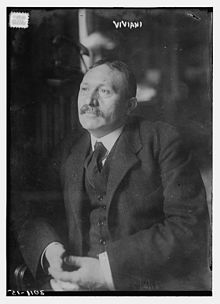René Viviani
René Viviani | |
|---|---|
 Viviani in 1914 | |
| 81st Prime Minister of France | |
| In office 13 June 1914 – 29 October 1915 | |
| Preceded by | Alexandre Ribot |
| Succeeded by | Aristide Briand |
| Personal details | |
| Born | 8 November 1863 Sidi Bel Abbès, French Algeria |
| Died | 7 September 1925 (aged 61) Le Plessis-Robinson |
| Political party | PRS |
Jean Raphaël Adrien René Viviani (French pronunciation: [ʁəne vivjaˈni]; 8 November 1863 – 7 September 1925) was a French politician of the Third Republic, who served as Prime Minister for the first year of World War I. He was born in Sidi Bel Abbès, in French Algeria. In France he sought to protect the rights of socialists and trade union workers.
Biography
René Viviani was born in Algeria in a family of Italian immigrants. His parliamentary career began in 1893, when he was elected deputy of the fifth ward in Paris. He retained this office until 1902, when he failed to be reelected, but four years later he was elected deputy of the Department of Creuse. In the same year he entered the cabinet of Georges Clemenceau. At an early age he associated himself with the Socialist party, soon becoming one of its most brilliant orators and prominent leaders. When the party was reorganized in 1904 into the Unified Socialist party, Viviani, like fellow Socialist Aristide Briand, stayed outside, and thenceforth called himself an Independent Socialist. He served as Minister of Public Instruction in the ministry of M. Doumergue. In the spring of 1914 an exceptionally radical chamber was elected, and for a while it seemed that they would be unable to agree upon any one for Premier, but finally, he was appointed Prime Minister on 13 June 1914, by President Poincaré. He received a vote of confidence of 370 to 137. The chief issues were the maintenance of the law requiring three years' service in the army and provision for a loan of 1,800,000,000 francs ($360,000,000) for military preparations. Viviani supported both of these measures. During the July Crisis, he was largely dominated by the President, Raymond Poincaré. Shortly, the war with Germany commenced, and in August, 1914, Viviani reorganized his cabinet on a war basis. His tenure leading France during the war was undistinguished. He retained the premiership for over a year, but resigned on 27 October 1915, being succeeded by Aristide Briand.
Viviani's First Government, 13 June – 26 August 1914
- René Viviani – President of the Council and Minister of Foreign Affairs
- Adolphe Messimy – Minister of War
- Louis Malvy – Minister of the Interior
- Joseph Noulens – Minister of Finance
- fr – Minister of Labour and Social Security Provisions
- Jean-Baptiste Bienvenu-Martin – Minister of Justice
- fr – Minister of Marine
- Victor Augagneur – Minister of Public Instruction and Fine Arts.
- Fernand David – Minister of Agriculture
- Maurice Raynaud – Minister of Colonies
- René Renoult – Minister of Public Works
- Gaston Thomson – Minister of Commerce, Industry, Posts, and Telegraphs
Changes
- 3 August 1914 – Gaston Doumergue succeeds Viviani as Minister of Foreign Affairs. fr succeeds l'Aude as Minister of Marine. Albert Sarraut succeeds Augagneur as Minister of Public Instruction and Fine Arts.

Viviani's Second Ministry, 26 August 1914 – 29 October 1915
- René Viviani – President of the Council
- Théophile Delcassé – Minister of Foreign Affairs
- Alexandre Millerand – Minister of War
- Louis Malvy – Minister of the Interior
- Alexandre Ribot – Minister of Finance
- Jean-Baptiste Bienvenu-Martin – Minister of Labour and Social Security Provisions
- Aristide Briand – Minister of Justice
- Victor Augagneur – Minister of Marine
- Albert Sarraut – Minister of Public Instruction and Fine Arts
- Fernand David – Minister of Agriculture
- Gaston Doumergue – Minister of Colonies
- Marcel Sembat – Minister of Public Works
- Gaston Thomson – Minister of Commerce, Industry, Posts, and Telegraphs
- Jules Guesde – Minister without Portfolio
Changes
- 13 October 1915 – Viviani succeeds Delcassé as Minister of Foreign Affairs.
See also
- Square René Viviani is a small public space near Notre-Dame in central Paris, named for Viviani
External links
References
- This article incorporates text from a publication now in the public domain: Gilman, D. C.; Peck, H. T.; Colby, F. M., eds. (1905). New International Encyclopedia (1st ed.). New York: Dodd, Mead.
{{cite encyclopedia}}: Missing or empty|title=(help)
